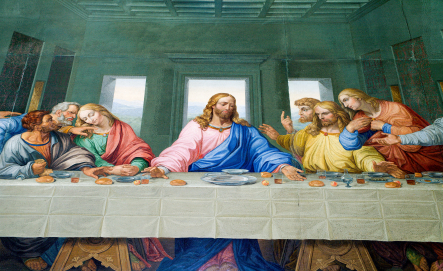By Tracy Taylor Grondine
 A recent effort by scholars to uncover the origins of America’s obesity problem turned up some interesting findings. Their research, while unorthodox, yet highly entertaining, examined 52 artists’ paintings of The Last Supper from the year 1,000 A.D. to the year 2,000 A.D. The results: Portion size has been increasing for 1,000 years
A recent effort by scholars to uncover the origins of America’s obesity problem turned up some interesting findings. Their research, while unorthodox, yet highly entertaining, examined 52 artists’ paintings of The Last Supper from the year 1,000 A.D. to the year 2,000 A.D. The results: Portion size has been increasing for 1,000 years
The researchers argue that enlarged portions are not a recent phenomenon, as critics suggest. Instead, they say it’s been a trend for the past millennium. Looking at the 52 paintings of The Last Supper, the meal entrees gradually grew by about 70 percent and the bread by 23 percent. Furthermore, the size of the apostles’ plates increased by nearly 66 percent.
While some critics blame modern farming and the advent of take-out food in the last 40 years for America’s fat problem, the authors instead suggest it’s a natural consequence of “dramatic socio-historic increases in the production, availability, safety, abundance and affordability of food” that started more than 1,000 years ago.
Yet, why now is obesity becoming such a prominent issue socially, commercially and even politically?
Everywhere you look, attention is being drawn to America’s eating habits. First Lady Michelle Obama recently launched a campaign urging children to eat healthy and get moving. Celebrity chef Jamie Oliver, whose hard-line diligence paid off in reforming the U.K’s school lunch program, has now set his sights on America’s students. And the head of Sony Pictures within the past few weeks has made a plea to movie theater owners to provide healthy snack alternatives to popcorn and candy.
One can argue that food portions have grown significantly over the last 20 years. Take movie popcorn for example. Twenty years ago the average size of the theater treat was five cups, equal to 270 calories. Today, movie goers instead typically buy a tub that weighs in at 630 calories.
The super size trend continues in everything from bagels to burgers to pasta dishes to desserts. What used to be considered an extra large soda is now deemed a medium. Unfortunately, America’s waistbands have reacted accordingly. Approximately 65 percent of U.S. adults are overweight or obese.
It’s not just food portions that have increased. The size of plates, bowls and cups have, as well. In the early 1990s, the standard size of a dinner plate increased from 10 to 12 inches. Correlating studies find that the larger the container, the more people consume, whether they are hungry or not.
So, what is the right portion size? Think of it this way. Your hamburger should be the size of a deck of cards, a slice of bread the size of a cassette tape, a baked potato the size of a computer mouse and a portion of pasta should be the size of a tennis ball.
But, portion size is not the only factor playing a role in our weight problem. A sedentary lifestyle, coupled with stress (which is arguably America’s number one health problem) and personal food choices are all culprits.
Unfortunately, we don’t have statistics reaching back to the date of the original Last Supper to correlate the affordability and safety of our food supply with growing portion size. But that would be too black and white anyway. America’s obesity problem can’t be pinpointed to one industry or one lifestyle habit. Like Leonardo da Vinci’s brilliant masterpiece, it has many layers and can’t be simplified in one brushstroke. It requires thorough examination.
*************************************************************************************
Tracy Taylor Grondine is director of media relations for the American Farm Bureau Federation.
Arizona Farm Bureau is a grassroots organization dedicated to preserving and improving the Agriculture industry through member involvement in education, political activities, programs and services.
For more information contact Julie Murphree at (480) 635-3607 or go to http://www.azfb.org.

